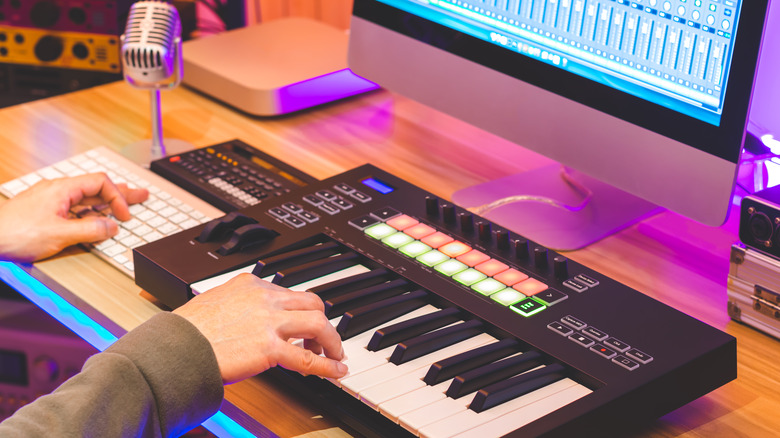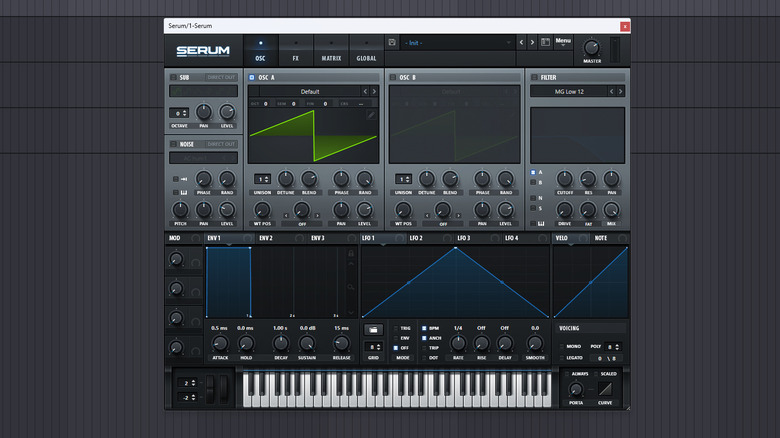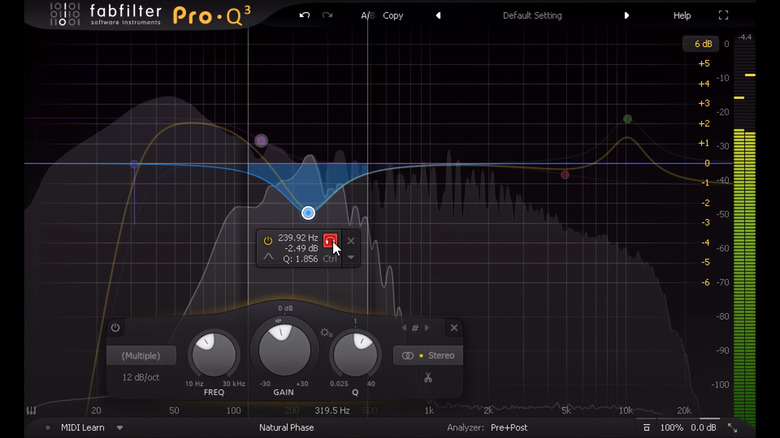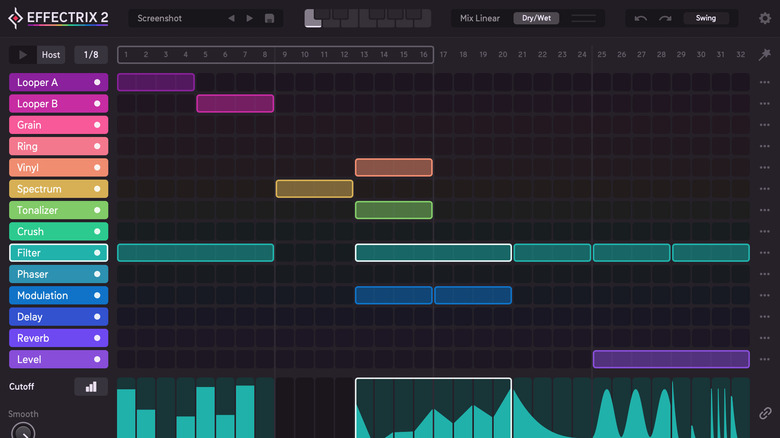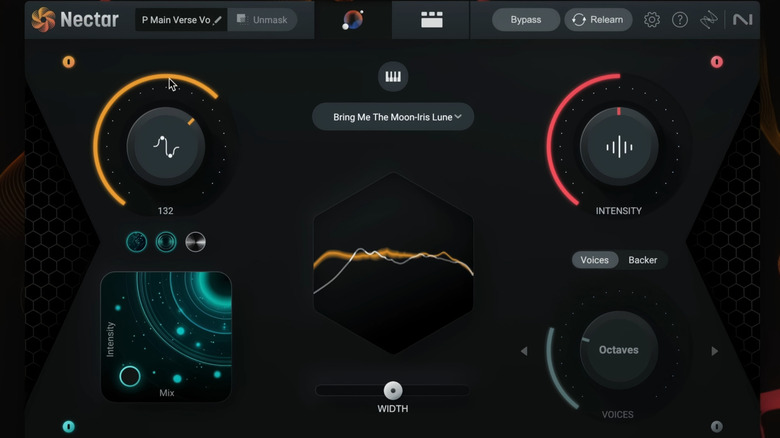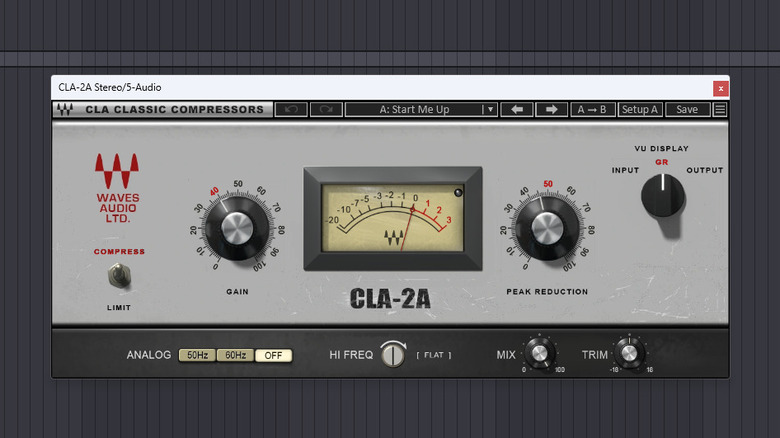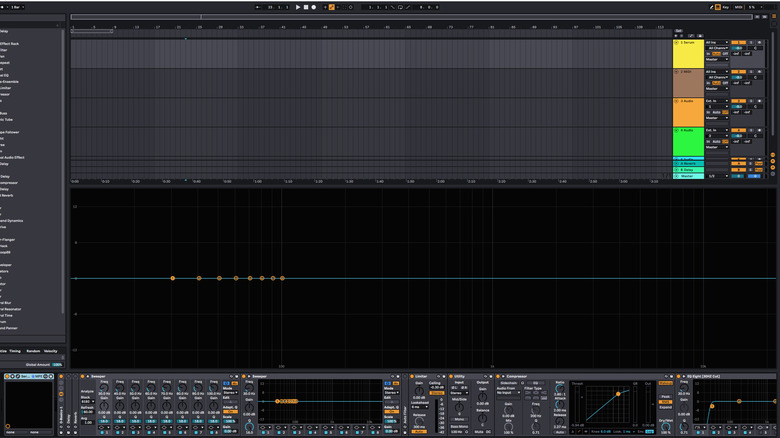5 Of The Best Music Production Plugins For New Producers
Those who are beginning their journey into the world of digital audio production dream of making the next viral hit song or tearing up club dance floors. But long before any of that can happen, you'll need to sit down and write a song. The first steps are obvious. You need a computer to produce on, as well as a digital audio workstation (DAW) software and a decent pair of speakers or headphones. From there, things get even more exciting as you explore the world of plugins, creating unique sounds with software synthesizers, adding effects, and mixing. However, this period of exploration is also the point at which things get a lot more confusing. With so many software plugins on the market and so many opinions regarding which are worth it, many novice producers quickly feel out of their depth.
If you think of your DAW as a kitchen, plugins are the cooking utensils and ingredients you'll need to create a musical meal. Often referred to as VSTs due to the .VST file extension that identifies them (on MacOS, they're .AU files, but don't worry about that), they range from software instruments and synthesizers that create the sounds themselves to audio effects and mixing tools that shape and alter them. But like kitchen utensils, they range in both price and usefulness and often, it's hard to know which are worth it until you've gotten a taste of them.
Coming up with five of the best audio production plugins for new producers to make things a bit easier based on my decade-long experience behind the dials (more on this later). Each of these plugins will be immediately useful to producers at any skill or experience level, including some synths, mixing tools, and effects that will bring you one step closer to making your next banger.
Xfer Serum
Veteran producers, stand down. Yes, Xfer Serum has become a bit of a cliché, but that's because it remains the most versatile wavetable synthesizer on the market, and anyone starting out with music production should be aware of it. For those out of the loop, Serum was created by production legend Steve Duda. It is a user-friendly and endlessly customizable synthesizer that uses wavetable synthesis to create dynamic sounds. It has been used on some of the biggest hit songs in dance music over the past decade by artists including Skrillex, Zedd, and Martin Garrix to create powerful basslines, driving lead synths, and much more.
Wavetable synthesis works by taking waveforms — the visual representation of a sound's change in amplitude over time — and passing them through various oscillators, filters, and effects. As opposed to more traditional methods like subtractive synthesis, wavetable synths are far more customizable, opening up infinite sound design options. Serum couples that versatility with an easy-to-learn interface that includes drag-and-drop routing for modulation, a built-in FX rack (give Hyper/Dimension a try if you want a sound to really pop), and a massive library of preset patches. Users can, of course, create, save, and share their own presets.
Serum costs $189 at the time of writing, but for those who don't want to cough up the cash all at once, you can rent to own it through Splice for $9.99/month for 19 months.
FabFilter Pro-Q 3
Once you've loaded your sounds into your DAW, be they MIDI instruments or audio files, you'll need a good EQ to shape them and ensure they're balanced in the mix. That's where FabFilter Pro-Q 3 comes in. It's one of the most fully featured and user-friendly EQs on the market.
Music plugins walk a tricky line between aesthetics, functionality, and user-friendliness. Make things too simple, and you're leaving functionality on the table, but make them too complex, and users may find them hard to learn. Pro-Q 3 checks all three boxes with ease. Not only is it a gorgeous piece of software with bright colors, but those aesthetics have intention behind them, helping users see what they're doing more clearly and intuitively. While traditional EQ plugins have controls on one side and a visual interface on the other, Pro-Q 3 blends the two, so controls only appear based on what you're doing in the software. The learning curve of Pro-Q 3 also scales with your skill level, so the better you get at using it, the more tricks you'll find up its sleeve.
For example, you can double-click anywhere within the Pro-Q 3 visualizer to add a new band. Then, when manipulating that band, controls will appear at the bottom of the interface, as well as right next to the band node. The type of band that's created depends on where along the audio frequency spectrum the band is added. If you add it in the low bass zone, Pro-Q 3 will make it a high-pass filter, while if added on the highs, it will automatically low-pass. Pro-Q 3 costs $169 from FabFilter at the time of writing, but be on the lookout for deals through third-party plugin stores.
Sugar Bytes Effectrix 2
If you've got a groove for ghoulish glitches or glitzy effects, you'll probably fall instantly in love with Effectrix 2, an effects sequencer from Sugar Bytes. In simple terms, it applies a range of effects over a given time period. The layout mimics the arrangement view of a DAW, letting you sequence different effects anywhere along a bar measure or a time signature of your choosing. While you could accomplish a similar sound by spending hours messing with your DAW's effects rack and automating each plugin, Effectrix is a one-stop shop that will accomplish the same thing in minutes.
The software includes two loopers, a grain delay, a ring modulator, vinyl distortion, filter sweep, delay, reverb, phaser, and several other effects. Each has a range of settings that can be adjusted to dial in the sound you're looking for, and multiple effects can be stacked atop one another. Each effect also has its own independent wet/dry knob, so you can choose how much of the audio signal is affected, and of course, there's a global wet/dry, too. If you'd rather leave things up to chance, there are a slew of randomization options to create unique parameters. Once you're finished creating a sequence, you can save it as a preset to reuse later.
More than anything else, the experience of using Effectrix is just plain fun. Creating glitchy beds of fake synths out of a vocal sample, turning a guitar riff into a bouncy house lead, or making a bassline spin wildly out of control injects a satisfying sense of playfulness into any production session. Even better, it will have other producers asking you, "How did you do that?" Effectrix 2 costs $129 directly from Sugar Bytes at the time of writing.
iZotope Nectar 4
If you work with vocals regularly, you know how hard it can be to figure out the right processing chain. Unlike synths or even live instruments, human voices are unpredictable and messy. What sounds fantastic on one vocal is unlikely to work on another. Thankfully, iZotope has the answer in a plugin called Nectar 4, which is an all-in-one vocal processing suite. Its marquis feature is Vocal Assistant, a tool that uses AI to analyze a vocal and apply the correct EQs, compressors, reverb, and much more with the click of a button. This makes it an ideal starting point for beginners.
Nectar 4's Vocal Assistant works surprisingly well. While seasoned professionals may nitpick the results, the AI tends to bring a vocal generally into alignment with the rest of the mix, requiring only a few small tweaks after the fact if you simply want a generic-sounding mix. Other nice-to-have features in Nectar 4 include a voices tool that lets you add harmonies, a feature that artificially generates background singers to add even more flavor to the vocal, and a module that manages levels across a vocal, which iZotope advertises as an alternative to compressors. Additionally, some versions of Nectar 4 come with Melodyne 5 essential, the industry-leading vocal tuning and pitch correction tool.
If purchased from iZotope or its parent company, Native Instruments, Nectar 4 Advanced costs $299, while Nectar 4 Standard costs $199, and Nectar 4 Elements, the most stripped-back version, costs $49. iZotope occasionally runs sales, and you can be on the lookout for further discounts from third-party plugin stores.
Waves CLA-2A
Every producer needs a compressor they can rely on, and for those starting out, you'll be using software compression. It's hard to think of a better compressor to start out with than the Waves CLA-2A plugin. Despite its clunky and technical-sounding name, CLA-2A is dead simple to use and is an extremely versatile compressor that sounds good on a wide variety of sounds and instruments. Taking its name from the classic electro-tube hardware compressor it was built to emulate, the Waves CLA-2A delivers what many describe as a "warm" sounding compression that brings out pleasing harmonics.
The main reason one would choose the CLA-2A over other compressors is that it controls sounds but retains a great deal of transparency, meaning that it does not alter or "muddy" the signal being processed through it. In other words, it keeps sound crystal clear while reining in dynamics. That's also the reason it's so versatile, able to be used on lead instruments, basses, and even in a mastering chain.
Additionally, the interface is mercifully simple. There are knobs for gain to set how amplified the signal is post-compression, peak reduction to determine the amount of compression on the signal, wet/dry to dial in how much of the outputted signal will have compression applied, and trim, along with a compress/limit switch to determine how aggressively peaks will be controlled.
Waves plugins are known to go on sale frequently. While the sticker price for CLA-2A directly from Waves at the time of writing is $249, you'll often see it plummet much cheaper, often as low as $30. Additionally, it may come as part of a bundle with other Waves plugins, which themselves are often heavily discounted.
Your DAW's stock plugins
If you're using one of the most popular DAWs, be it Ableton Live Suite, FL Studio, Logic Pro, or anything else of that caliber, it comes pre-loaded with a variety of included plugins. While many novice producers may assume these stock plugins aren't worth investigating, many of them are well worth a try. While other plugins on this list cost hundreds of dollars, some of the best free plugins include those that come with your DAW.
To use a couple of popular DAWs as examples, Ableton Live Suite 11 and 12 include tools like the EQ Eight, an 8-band EQ, Auto Filter, a simple but powerful band-pass filter, and Drum Buss, a drum processor that adds serious thump to any percussive elements. Meanwhile, FL Studio 21 includes plugins like Sakura, a highly regarded string synthesizer, Patcher, which lets users create custom effects chains and signal processing flows, and NewTone, a pitch correction tool.
Many popular songs have been created using mostly stock plugins and sounds, so don't get stuck in the mindset that you need to spend boatloads of money to make great music. It's always a good rule of thumb to master the tools you already own before you buy more. Think of your plugins like tools in a carpenter's toolbox. If you already have a hammer, you don't need another one unless the one you own can't get the job done. And if you're a beginner, fancier tools won't make you a better carpenter.
Methodology
The plugins in this guide were selected based on my more than a decade of music production experience. Each was chosen for its universal appeal, the quality of its output, and general popularity in the music production community. All of these products are central to my workflow, but none of the companies named in this article had any editorial input, nor is this article sponsored in any way.
